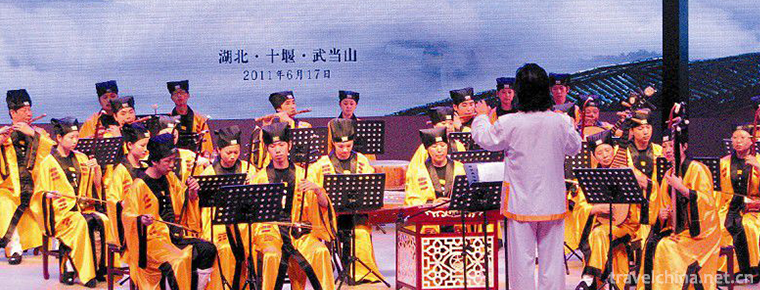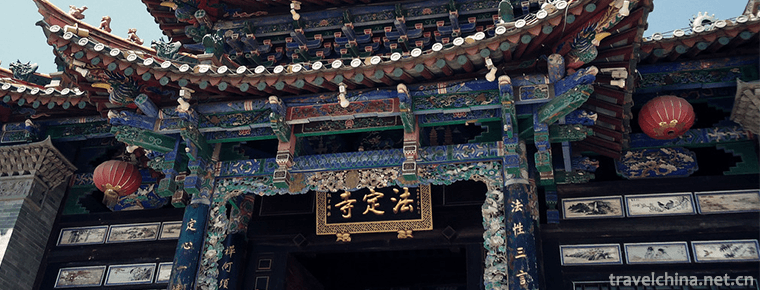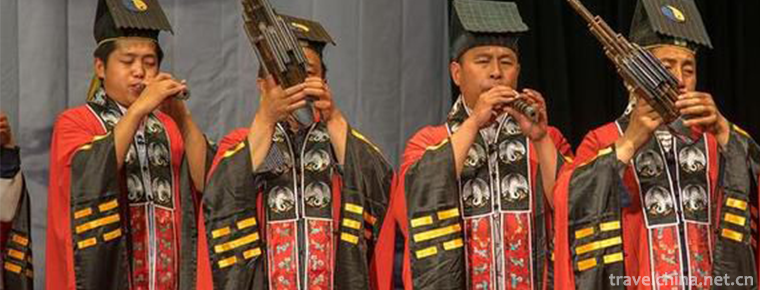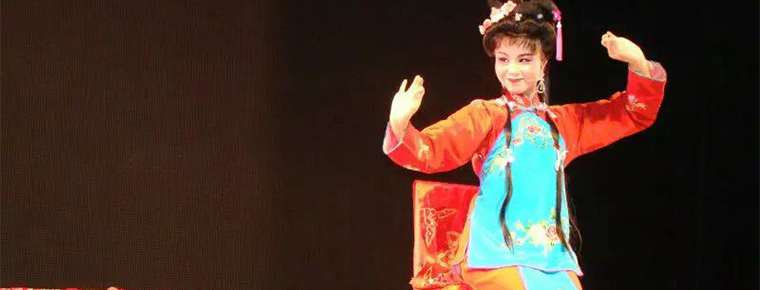Wudang Mountain Palace Viewing Taoist Music
Wudang Mountain Palace Viewing Taoist Music
Wudang Mountain Palace Taoist Music is the product of the combination of excellent traditional folk culture in Qinba area of Hubei Province and court music from Tang Dynasty to Ming Dynasty. It is the treasure of Chinese traditional music. Wudang Mountain Palace Taoist music is mostly a form of "song, dance and music". Brief introduction
Wudang Mountain, an ancient name of Taihe Mountain, is located in Shiyan City, northern Hubei Province. The mountain is magnificent. It faces the Danjiangkou Reservoir and is backed by Shennongjia Forest District, which covers more than 400 kilometers. There are 72 peaks, the main peak Tianzhu Peak is 1612 meters above sea level, the rest of the peaks are inclined to Tianzhu, which is a wonder. Since ancient times, Wudang Mountain has been the ideal place for Taoists to pursue fairyland. Taoist architecture has spread all over the mountain and its scale is magnificent. It is said that in ancient times, basalt rose in this way.
Since the birth of Taoism in the Eastern Han Dynasty, emperors in successive dynasties have held the ceremony of closing the mountains in Wudang several times. The reputation of Wudang Mountain has risen rapidly, and it once ranked above the five mountains in the Ming Chengzu period, known as "Dayue". Zhang Sanfeng, a master of a generation, made Wudang Mountains truly famous. His Wudang School and Songshan Shaolin School were equally famous for Taoist music. They are also called "Taoist music" for short. They are also called "Zhai Li music", "legal music" and "Tao Chang music", which are used to cooperate with various ritual activities of Taoism.
Wudang Mountain Palace Taoist Music is a combination of excellent folk culture in Qinba area and court music from Tang Dynasty to Ming Dynasty. It is a treasure of Chinese national music. Wudang Mountain Palace Taoist music is mostly a form of "song, dance and music".
Historical Origin
During the Zhenguan period of the Tang Dynasty, Wudang Mountain began to build the Wulong Temple. Since then, Taoist sects such as Zhengyi and Quanzhen began to preach in the mountains, and famous Taoist teachers of all dynasties have also lived in seclusion and practiced here. Long-term religious activities have left a wealth of musical materials. Wudang Mountain Palace Taoist Music not only retains the musical characteristics of Quanzhen School's "Ten Rhymes", but also has the melting charm of multi-sect music, and all kinds of rhymes and instruments are well-known, which is an important cultural heritage of Taoist music.
artistic characteristics
As Taoism is a native religion in China, Taoist music has traditional characteristics and strong national style. It is divided into vocal music and instrumental music. Its melody is ancient and elegant, rich in content, with the joy of praying for auspicious festivities, as well as the quiet melody of cultivating purity. Listening to fairy music and Wuxian Tao, you can experience the fairyland interest of "this song should only be seen in the sky, and can be heard several times in the world". Wudang Mountain court music and folk music in one. Genre forms can be divided into "rhyme tune" and "brand". According to the different performance occasions, objects and purposes, "rhyme tune" can also be divided into "Yang tune" and "Yin tune", "brand" can be divided into "Zhengqu", "Qiaoqu" and "Fa instrument brand".
Common instrumental music cards are goats on hillsides, , , etc., and chanting cards are [general support], , , etc. According to the content of its activities, it can be roughly divided into three categories: monastic law, fasting law and commemorative law music. Moral music is the daily work of Taoist self-cultivation, referred to as "morning and evening classes" or "morning and evening altar". Legality music is the ritual music of Taoist sacrifice and prayer. It is used to pray for all kinds of solitary spirits, wild ghosts or deceased people in order to avoid disaster.
The commemorative activities of Wudang Mountain mainly include March 3, September 9, July 1/2 and Kaiguang.
Representative Works
Common instrumental music cards are goats on hillsides, , , etc., and chanting cards are [general support], , , etc.
Inheritance Significance
Since the opening of Wudang Mountain to the outside world in 1982, especially in 2000, the Work Committee and Management Committee of Wudang Mountain Special Zone have taken effective measures to protect, develop and utilize Wudang Mountain Palace Taoist Music. Wudang Mountain Palace Taoist Music is going abroad and going to the world. In the view of Wudang Mountain Palace, "Xuanmen Daily Recitation Morning and Evening Class", "Zushibiao", "Sazu Iron Cans for Food and Alchemy" and other (complete) ritual music have been timely inherited, properly and completely preserved. The ancient and pure tune of Wudang Mountain Palace Taoist music is irreplaceable by any other music. It has greatly broadened the discipline of national music and left profound enlightenment for the development of our national music.
Brief introduction
Wudang Mountain, an ancient name of Taihe Mountain, is located in Shiyan City, northern Hubei Province. The mountain is magnificent. It faces the Danjiangkou Reservoir and is backed by Shennongjia Forest District, which covers more than 400 kilometers. There are 72 peaks, the main peak Tianzhu Peak is 1612 meters above sea level, the rest of the peaks are inclined to Tianzhu, which is a wonder. Since ancient times, Wudang Mountain has been the ideal place for Taoists to pursue fairyland. Taoist architecture has spread all over the mountain and its scale is magnificent. It is said that in ancient times, basalt rose in this way.
Since the birth of Taoism in the Eastern Han Dynasty, emperors in successive dynasties have held the ceremony of closing the mountains in Wudang several times. The reputation of Wudang Mountain has risen rapidly, and it once ranked above the five mountains in the Ming Chengzu period, known as "Dayue". Zhang Sanfeng, a master of a generation, made Wudang Mountains truly famous. His Wudang School and Songshan Shaolin School were equally famous for Taoist music. They are also called "Taoist music" for short. They are also called "Zhai Li music", "legal music" and "Tao Chang music", which are used to cooperate with various ritual activities of Taoism.
Wudang Mountain Palace Taoist Music is a combination of excellent folk culture in Qinba area and court music from Tang Dynasty to Ming Dynasty. It is a treasure of Chinese national music. Wudang Mountain Palace Taoist music is mostly a form of "song, dance and music".
Historical Origin
During the Zhenguan period of the Tang Dynasty, Wudang Mountain began to build the Wulong Temple. Since then, Taoist sects such as Zhengyi and Quanzhen began to preach in the mountains, and famous Taoist teachers of all dynasties have also lived in seclusion and practiced here. Long-term religious activities have left a wealth of musical materials. Wudang Mountain Palace Taoist Music not only retains the musical characteristics of Quanzhen School's "Ten Rhymes", but also has the melting charm of multi-sect music, and all kinds of rhymes and instruments are well-known, which is an important cultural heritage of Taoist music.
artistic characteristics
As Taoism is a native religion in China, Taoist music has traditional characteristics and strong national style. It is divided into vocal music and instrumental music. Its melody is ancient and elegant, rich in content, with the joy of praying for auspicious festivities, as well as the quiet melody of cultivating purity. Listening to fairy music and Wuxian Tao, you can experience the fairyland interest of "this song should only be seen in the sky, and can be heard several times in the world". Wudang Mountain court music and folk music in one. Genre forms can be divided into "rhyme tune" and "brand". According to the different performance occasions, objects and purposes, "rhyme tune" can also be divided into "Yang tune" and "Yin tune", "brand" can be divided into "Zhengqu", "Qiaoqu" and "Fa instrument brand".
Common instrumental music cards are goats on hillsides, , , etc., and chanting cards are [general support], , , etc. According to the content of its activities, it can be roughly divided into three categories: monastic law, fasting law and commemorative law music. Moral music is the daily work of Taoist self-cultivation, referred to as "morning and evening classes" or "morning and evening altar". Legality music is the ritual music of Taoist sacrifice and prayer. It is used to pray for all kinds of solitary spirits, wild ghosts or deceased people in order to avoid disaster.
The commemorative activities of Wudang Mountain mainly include March 3, September 9, July 1/2 and Kaiguang.
Representative Works
Common instrumental music cards are goats on hillsides, , , etc., and chanting cards are [general support], , , etc.
Inheritance Significance
Since the opening of Wudang Mountain to the outside world in 1982, especially in 2000, the Work Committee and Management Committee of Wudang Mountain Special Zone have taken effective measures to protect, develop and utilize Wudang Mountain Palace Taoist Music. Wudang Mountain Palace Taoist Music is going abroad and going to the world. In the view of Wudang Mountain Palace, "Xuanmen Daily Recitation Morning and Evening Class", "Zushibiao", "Sazu Iron Cans for Food and Alchemy" and other (complete) ritual music have been timely inherited, properly and completely preserved. The ancient and pure tune of Wudang Mountain Palace Taoist music is irreplaceable by any other music. It has greatly broadened the discipline of national music and left profound enlightenment for the development of our national music.


-
Serdang snow mountain Xiling snow mountain
Xiling Snow Mountain, located in Dayi County, Chengdu City, Sichuan Province, is only 95 kilometers away from Chengdu, with a total area of 483 square kilometers. It is a world natural heritage.
Views: 139 Time 2018-10-30 -
QomolangmaEverest
Mount Qomolangma (Mount Qomolangma) is the main peak of the Himalayas and the highest mountain in the world. It is located on the border between China and Nepal. The peak is located in China.
Views: 284 Time 2018-10-30 -
Hakka stuffed tofu
Hakka-brewed tofu, also known as minced meat-brewed tofu and Dongjiang-brewed tofu, is one of Hakka's famous dishes and is said to be related to....
Views: 127 Time 2018-11-02 -
Hao River
Haohe River surrounds the old city of Nantong, like a gourd, like a Pearl chain, known as the "emerald necklace" of Nantong City. It is a national 5A tourist attraction..
Views: 190 Time 2018-12-06 -
Ancient town of Guandu
Guandu Town, located in the Southeastern Suburb of Kunming, is one of the famous historical and cultural ancient towns in Kunming. Guandu ancient town gate (big archway) is located in the southeastern.
Views: 137 Time 2019-01-13 -
Kuanguo Museum
The Kuanguo Museum is a special museum built on the site of the Kuanguo Cemetery in the Western Zhou Dynasty, a national key cultural relic protection unit. It covers an area of 100,000 square meters.
Views: 206 Time 2019-01-13 -
Yanmenguan Scenic Area
Yanmenguan Scenic Spot is located in the northern part of Daizhou ancient city. South-controlled Central Plains and North-controlled Moyuan are grand military defense projects of ancient Chinese passe.
Views: 106 Time 2019-03-01 -
Sheng Guanyue in Jizhong
Jizhong Sheng wind music is popular in Jizhong Plain, that is, south of Beijing, west of Tianjin, north of Cangzhou and Dingzhou frontline nearly 30 counties and cities of traditional drum music varie.
Views: 303 Time 2019-05-05 -
Sizhou opera
Sizhou Opera is one of the four major operas in Anhui Province. Its original name is Lahun Opera. It has a history of more than 200 years. Many people think that it originated in Haizhou, northern Jia.
Views: 120 Time 2019-06-16 -
Beijing Electronic Science and Technology Institute
Beijing Electronic Science and Technology Institute is a general university which trains specialists in information security and office automation for Party and government organs at all levels. The Co.
Views: 149 Time 2019-09-06 -
Neijiangs location
Neijiang City is located in the southeast of Sichuan Basin and the middle of the lower reaches of Tuojiang River. Chongqing in the East, Chengdu in the west, Zigong, Yibin and Luzhou in the south, Ziyang and Suining in the north. Its geographical location.
Views: 340 Time 2020-12-16











